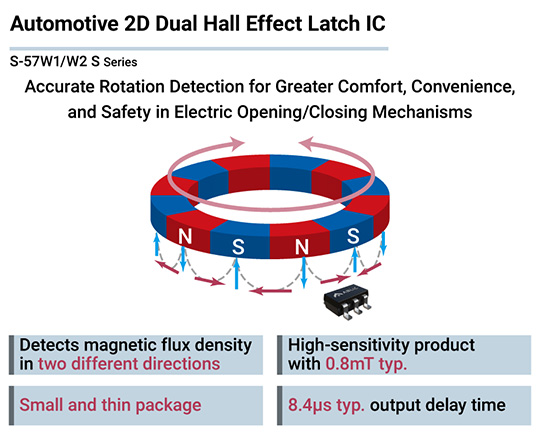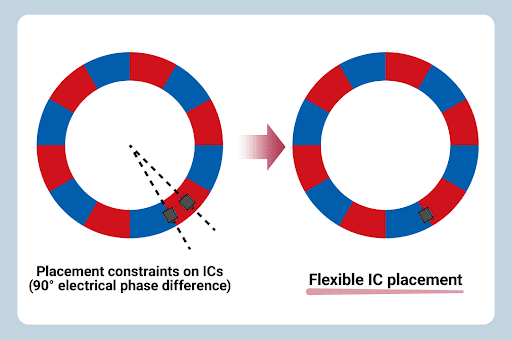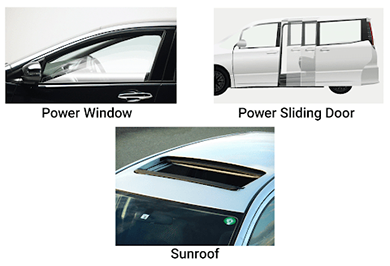2025
Sept.18, 2025
MINEBEA MITSUMI Inc.
ABLIC Launches the S-57W1/W2 Series of Automotive 2D Dual Hall Effect Latch IC
- Detects Both Rotation Speed and Direction in a Single Chip, Enhances Ease of Motor Applications' Design -


MinebeaMitsumi Group
Green Products
ABLIC Inc. (President: Seiji Tanaka; Head Office: Minato-ku, Tokyo; hereinafter "ABLIC"), a group company of MinebeaMitsumi Inc., today announced the launch of sales for the S-57W1/W2(*1) series of automotive 2D dual hall effect latch IC.
The S-57W1/W2, is a 2D dual hall effect latch IC that converts mechanical rotational motion into electrical signals. It outputs pulse signals representing changes in relative position from the start of motor operation, making it ideal for incremental encoder applications, where information such as rotation speed and direction is derived from this signal.
Previously, detecting mechanical rotational motion required two ICs, each capable of sensing magnetic flux in only one direction. The S-57W1/W2, however, contains a single chip with built-in Hall elements that detect magnetic flux density in two different directions, enabling detection with just one IC. With the industry's highest magnetic sensitivity of 0.8 mT (typ.) (*2), the IC achieves high-resolution rotational detection.
The product is available in the standard SOT-23-5 package (2.9 × 2.8 × t1.3 mm) and the HSNT-6 package (2025, 1.96 × 2.46 × t0.5 mm), which is the industry's thinnest (*3) 2D dual hall effect latch IC package, making it suitable for space-constrained applications.
With the rise of vehicle electrification and advances in autonomous driving, the number of motors in automobiles continues to grow, components such as power windows, sunroofs, power sliding doors, and power liftgates now require smooth operation and precise positioning. The S-57W1/W2 detects the rotational speed and direction of motors driving these components with high precision, all on a single chip.
- (*1) The S-57W1 Series outputs a signal indicating the direction of rotation from the OUT1 pin and a signal indicating the rotation speed from the OUT2 pin. The S-57W2 Series outputs an "H" (High) or "L" (Low) signal from the OUT1 and OUT2 pins, respectively, according to the magnetic flux density and magnetic field polarity of their corresponding detection axes.
- (*2) Based on our research as of September 2025.
- (*3) Based on our research as of September 2025.
Major Features
- 1. Single IC Detects Magnetic Flux in Two Directions
- In a rotational detection mechanism using two Hall ICs—each capable of detecting only a vertical magnetic field—there was a constraint that the two ICs had to be positioned to detect signals with a 90-degree phase difference.
The S-57W1/W2 integrates Hall elements that detect magnetic flux in two different directions within a single IC chip, automatically generating signals with a 90-degree phase difference. This significantly improves ease of design and eliminates the need to redesign the circuit board when changing the number of magnetic poles on a multi-pole ring magnet. - 2. Industry-Leading High Sensitivity Enables Detection of Weak Magnetic Flux in Multi-Pole Ring Magnets
- Increasing the number of magnetic poles on a ring magnet is an effective way to improve the resolution of rotational detection. However, adding more poles reduces the volume of each magnetized section, which in turn weakens the magnetic flux density.
- The S-57W1/W2 series includes a high-sensitivity version with a value of 0.8 mT typ., enabling detection of even weak magnetic flux densities. This makes it suitable for use with ring magnets featuring a high number of poles.
- 3. Industry's Thinnest Small Package for Low-Profile Motor Applications
- Motors must meet various size and thickness requirements depending on their application. The S-57W1/W2 is offered in the HSNT-6 (2025) package, the thinnest small package for a 2D dual hall effect latch IC. This makes it ideal for compact, low-profile motor applications with limited mounting space.
- 4. Short Output Delay Time Enables High-Speed Rotational Tracking
- The S-57W1/W2 has a short output delay time of 8.4 µs typ., allowing it to detect rapid changes in the magnetic field. This allows reliable rotational detection for high-speed motors.

Major Specifications
| • Output Type | Selectable from :
|
|---|---|
| • Detection Axis | Selectable from :
|
| • Output Logic | For Rotation Speed / Direction Output Type :
|
| • Output Configuration | Selectable from :
|
| • Magnetic Sensitivity | Selectable from :
|
| • Output Delay Time | 8.4 µs typ. |
| • Package | Selectable from :
|
Example Use Cases
- Motor rotation detection for vehicle opening/closing systems.
- Rotation detection for dial-type controllers.
Application Examples

Power windows, sunroofs, power sliding doors, power liftgates, dial-type controllers, etc.
Product Details
In addition to the automotive-grade S-57W1/W2, ABLIC is also simultaneously launching the consumer-use S-5791/92 2D dual hall effect latch IC today. Featuring the same key characteristics, this IC is suitable for a wide range of consumer motor applications, including pedal rotation detection in electric bicycles, power tools, and robotic vacuum cleaners.
Website
https://www.ablic.com/en/semicon/ ![]()

This product has been certified as a MinebeaMitsumi Group "Green Product" for its outstanding contribution to the environment.
| Contacts | ABLIC Inc. Masae Onuma E-mail: pr@ablic.com https://hub.ablic.com/en/pr-inquiry?rf=support Newsroom: www.mynewsdesk.com/ablic |
|---|
Product information, contact and other context are subject to change without prior notice.









